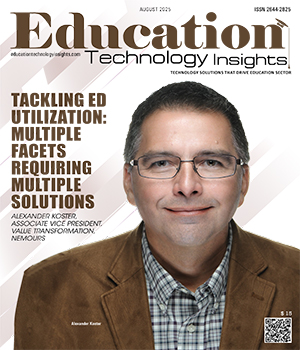THANK YOU FOR SUBSCRIBING
Be first to read the latest tech news, Industry Leader's Insights, and CIO interviews of medium and large enterprises exclusively from Education Technology Insights
Navigating the Grey: A New Framework for AI in Higher Education
Brett Hinson, VP of IT and CIO, Lipscomb University
 Brett Hinson, VP of IT and CIO, Lipscomb University
Brett Hinson, VP of IT and CIO, Lipscomb UniversityFor those of us who remember the dawn of the commercial internet, the current climate surrounding artificial intelligence feels familiar. We see the same mix of boundless enthusiasm, deep-seated skepticism and widespread uncertainty. I recall watching the 1983 film War Games, where a character typed a question into a computer and received an answer, and I thought it was pure science fiction. Yet here we are. The question for leaders in higher education is no longer if AI will change our world, but how we will lead through the transformation. Will we embrace the opportunity to learn, grow and change or will we watch from the sidelines as the future unfolds without us?
To navigate this new terrain, we can turn to a framework originally developed by the U.S. Army War College: VUCA. This acronym—representing Volatility, Uncertainty, Complexity and Ambiguity—perfectly describes the turbulent, unpredictable nature of the AI revolution.
• Volatility: The AI landscape shifts daily. New large language models (LLMs) and specialized tools emerge weekly, while existing products are constantly integrating new AI features. This rapid, significant change requires institutional agility and a willingness to rethink how work gets done.
• Uncertainty: With rapidly evolving capabilities and a lagging regulatory landscape, forecasting is difficult. We cannot wait for a government body or accrediting agency to give us the green light. We must move forward, and this is where managing risk becomes vital.
“Frame the investment in AI not just as a technological upgrade, but as a commitment to preparing students for a future workforce where AI is a ubiquitous partner.”
• Complexity: AI impacts every corner of the university. How do we meet the diverse needs of students who want AI for everything from basic administrative tasks to deep learning support? How do we empower faculty while managing the technological and data security risks of unvetted tools? These interconnected factors complicate decision making, demanding a holistic strategy rather than siloed or point solutions.
• Ambiguity: Best practices for leveraging generative AI in education are still being written. The situation is unclear, with incomplete information leading to multiple interpretations. As leaders, we cannot be held captive by this ambiguity. The only way beyond the grey is to go through it, leading with purpose even when the path isn't perfectly clear.
Leading through VUCA requires a proactive, principled approach. It’s an opportunity to reinforce foundational policies, like data handling and classification, that have been in place for years. By framing AI use within these existing structures, we can build a culture of responsibility. A useful guidepost is the SAFETY framework, ensuring that AI integration is Secure, Accountable, Fair, Ethical and Transparent. Marrying these principles with your institution’s unique mission is not just important; it is non-negotiable. So, where do we begin? The task may seem monumental, but the path forward is paved with strategic, incremental steps.
Implementation Considerations & Key Takeaways:
The journey begins not with a single, campus-wide decree, but with a commitment to exploration and learning. Allow faculty the time and resources to discern how AI can authentically enhance their pedagogy. Frame the investment in AI not just as a technological upgrade, but as a commitment to preparing students for a future workforce where AI is a ubiquitous partner. This requires hard discussions on funding, measuring value and creating accountability.
For university leaders charting this new course, consider these essential actions:
1. Embrace the VUCA Challenge: Acknowledge that volatility, uncertainty, complexity and ambiguity present both risks and opportunities. Address these factors proactively in your strategic planning.
2. Start Small with Strategic Pilots: Identify high-impact, low-risk use cases. Empower faculty champions to drive early adoption, gather feedback and learn from both successes and failures.
3. Develop an Ethical AI Framework: Establish clear guiding principles and policies to ensure AI integration aligns with your institutional values, academic integrity and student privacy.
4. Invest in Comprehensive Training: Provide robust, continuous professional development to enable faculty and staff to leverage AI tools effectively and ethically. Train, learn and train again.
5. Demonstrate Real-World Impact: Showcase successful AI implementation stories from your pilots to inspire peers, build momentum and guide broader campus adoption.
The age of AI is not a distant future; it is our present reality. By leading with courage through ambiguity, we can shape a future where technology serves our most cherished human-centered educational missions.
Read Also
Navigating the Grey: A New Framework for AI in Higher Education
Irreplaceable: Schools that Prepare Future-Ready Learners
Inspiring Futures Through Access and Opportunity
Reframing Social and Emotional Learning: From Reservations to Renewal
Innovative Leadership in Professional Learning Programs
Balancing Technology and People in a Dynamic School System

I agree We use cookies on this website to enhance your user experience. By clicking any link on this page you are giving your consent for us to set cookies. More info

However, if you would like to share the information in this article, you may use the link below:
www.educationtechnologyinsightseurope.com/cxoinsights/brett-hinson-nid-3528.html






















